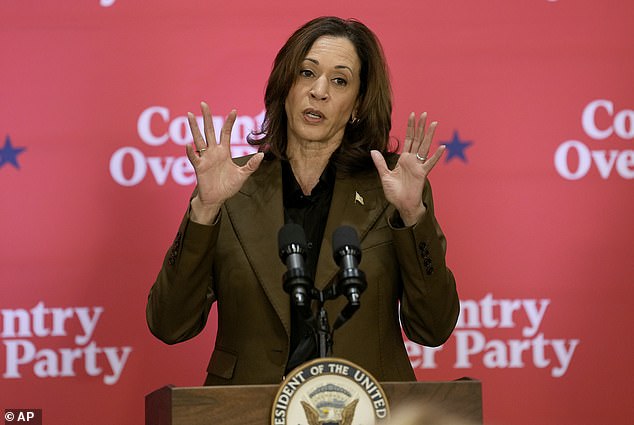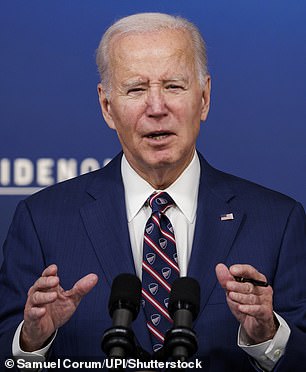ANDREW NEIL: The real reason black and Hispanic voters are abandoning Kamala for Trump – driven away by the Democrats’ delusional obsession with race
The first wave of panic begins to grip the Harris-Walz presidential campaign and Team Trump begins to believe that their man might win after all.
The momentum is back with Donald Trump and the Kamala Harris campaign is an increasingly unhappy, floundering ship with less than three weeks to go.
But Democrats are being forced to confront something more existential than the possibility of defeat on November 5: that for them, demographics may not be their party’s destiny after all.
It has long been a comforting axiom of Democratic thought that the more non-white America becomes, the more the Democrats are destined to be the natural party of government. After all, Democrats are supported by a comfortable majority of Hispanic and Asian voters, plus an overwhelming majority of black voters.
The more these minorities come together into a new American majority, the more Democrats can expect to win elections. For the party’s progressive wing, it promised the ultimate triumph of identity politics: make race the most important characteristic of what defines people, and future Democratic victories are in the offing.
The first wave of panic begins to grip the Harris-Walz presidential campaign and Team Trump begins to believe that their man might win after all.

The momentum is back with Donald Trump and the Kamala Harris campaign is an increasingly unhappy, floundering ship with less than three weeks to go.
Except for one thing that Democratic strategists never saw coming: Americans of color are steadily moving to the right.
It’s ironic that this only dawned on Democrats in the middle of their first presidential election, with a non-white, female candidate taking the lead, which many in the party thought would seal its demographic fate.
That they never saw it coming is illustrated by the way they wave their hands around to deal with it.
That Harris has a problem with black male voters has become clear the longer the campaign has gone on. Barack Obama was sent to Pittsburgh (the second largest metropolitan area in the most crucial swing states, Pennsylvania) last week to admonish black men for their lack of enthusiasm for Harris.
Too many black men, the former president argued, “don’t want a woman as president” in a lame intervention that did more harm than good.
If you’re out to win people’s votes, it’s probably not a good idea to portray them as sexist, or even misogynist. Ignoring what might really explain black men’s disillusionment with Democrats — slow wage growth, high housing costs, crime-ridden streets — could even be considered insulting.
Harris hasn’t fared much better. She rushed to be interviewed by a number of black media outlets, waving so-called forgivable loans (the kind you probably don’t have to pay back) for minority small businesses and the federal decriminalization of cannabis.
These implicit votes of black men could be purchased with a mixture of cash and weed, which was both demeaning and offensive.
No wonder Jim Clyburn, the black veteran Democratic congressman from South Carolina who saved Joe Biden’s failed 2020 primary, said on November 5 that he remained seriously “concerned about black men staying home or voting for Trump.”
The problem is real – and growing. Remarkably, Harris has less support among black voters in this presidential election than Hillary Clinton did when she lost to Trump in 2016.
A recent New York Times/Siena College poll starkly depicted the shift to the right among minority voters, especially among men, and especially among men without college degrees.
Among non-college-educated black voters, Democrats won by a margin of nearly 90 percentage points in 2016. This year, that has dropped to 65 percent, according to the NYT survey.
The Democratic loss among Hispanic voters is even greater: Eight years ago, Democrats had a 41 percentage point lead over the Republican Party among non-college-educated Hispanic voters; now it is expected to be only 16 percent.
The Democratic loss among Hispanic voters is even greater: Eight years ago, Democrats had a 41 percentage point lead over the Republican Party among non-college-educated Hispanic voters; this figure is now expected to be just 16 percent.
Of course, a majority of people of color will still vote Democrat on November 5. But not by the traditional landslide majorities that Democrats typically enjoyed—and that were necessary to secure overall victory.
Polls show that one in five black voters, two in five Hispanic voters and one in three voters of Asian descent are now seriously disappointed with Democrats. Four years ago, Biden could count on 89 percent of the black vote in the most important swing states. Harris’ share of the polls currently stands at 78 percent.
If less than one percentage point now separates the two presidential candidates in all seven swing states, that level of defection from the minority Democrats could be crucial to securing a Trump victory.
Some will see this as a welcome reward for Democrats and their obsession with identity politics. But the Democrats’ mistake wasn’t so much an overreliance on identity as a choice to make the right choice wrong identity.
It turns out that social class trumps race among ordinary minority voters, contrary to recent fashionable academic theories and the airy predictions of Democratic Party panjandrums.
Non-college-educated minority voters share the same economic frustrations, and even anger, as white working-class voters, which is why many are drawn to Trump.
White and non-white working-class voters think their wages rose faster under Trump than under Biden. Only 21 percent of Hispanic voters think Biden has helped them get ahead; but 38 percent think Trump did.
Minorities’ disillusionment with Democrats is not helped by the growing perception that the party is in the grip of an affluent metropolitan elite that does not share the values of ordinary minority voters who, it turns out, have more class solidarity with the white working class than with the white working class. posh people who now run the party they voted for so far.
This points to perhaps the biggest mistake of all that the Democratic elite made: They moved to reshape the party based on the fact that voters of color, like them, were overwhelmingly progressive. When in reality, minority voters are more likely to be moderate to conservative.


White and non-white working-class voters think their wages rose faster under Trump than under Biden. Only 21 percent of Hispanic voters think Biden has helped them get ahead; but 38 percent think Trump did.
They are tough on crime because they are more likely to be victims of it than rich white people.
They are not keen on transgender rights, especially when it comes to allowing biological males to participate in women’s sports.
They tend to be isolationist in foreign policy, preferring to have money spent on their problems at home rather than on military adventures abroad, where minorities will take on a disproportionate share of the fighting and ultimately a high percentage of the body bags will fill.
The Biden administration thought relaxed controls at the southern border were what Hispanic voters wanted and were required to do. It shows how inaccessible it was.
Working-class Hispanics, along with other minority voters, want strict border controls because their jobs — and not those of the metropolitan elite — are at risk from unchecked illegal immigration. That explains why 40 percent of black and Hispanic voters say all illegal immigrants should be deported and support building a border wall.
It’s almost as if the Trump agenda was created with minority voters in mind.
It’s baffling that Democratic Party strategists didn’t see this coming. After all, it’s happened before. The backbone of the Democratic Party used to be workers of Irish, Italian and Polish descent. But as they increased their share in American society, they became more conservative over time.
Some even started voting Republican. They played an important role in Ronald Reagan’s two presidential victories in 1980 and 1984. As a former Democrat, he proudly called them the Reagan Democrats.
I remember sitting in a spit-and-sawdust bar in upstate New York during the 1980 campaign. The clientele was clearly workers. A photo of John F. Kennedy hung proudly behind the bar.
“I think people here will vote for Democrats in the election,” I said to the bartender.
“Oh no,” he replied. ‘I vote Republican. Most of us are.”
His customers nodded approvingly. It was then, during a closely fought election, that I realized that Reagan would probably win.
The same phenomenon is happening now, this time among minority voters. It still might not be enough to secure Trump’s victory, as the rightward shift of minority voters is a process still in its infancy. And Harris’s “man problem” is matched by Trump’s “women problem.”
But minority drift is causing endless problems for Harris and her party. Whatever the outcome on November 5, Democrats can no longer take minority voters for granted — and their prospects of becoming the natural party of government are rapidly diminishing.
